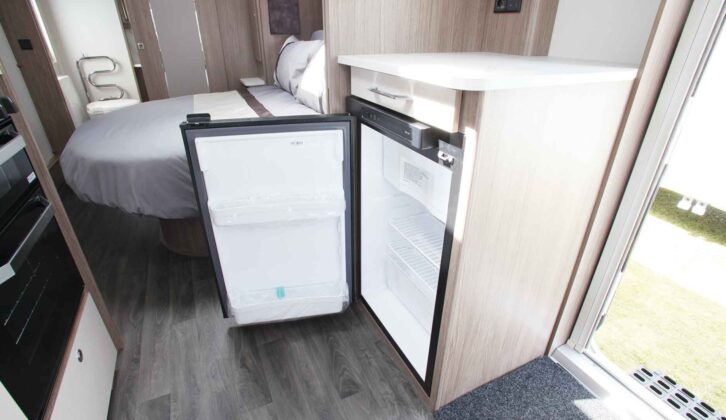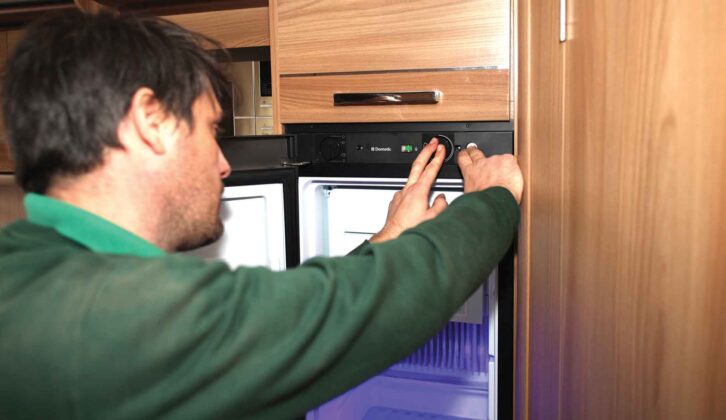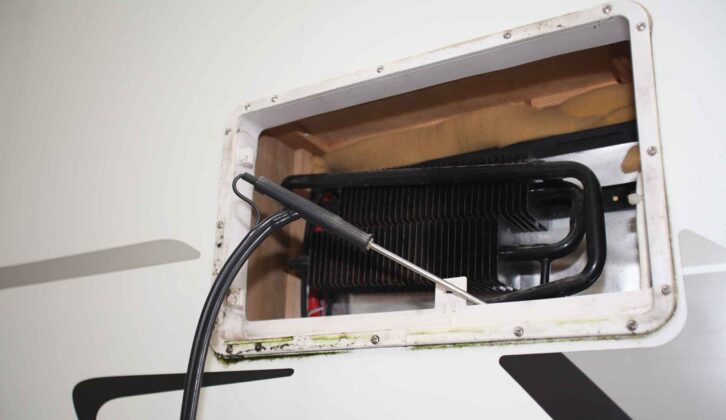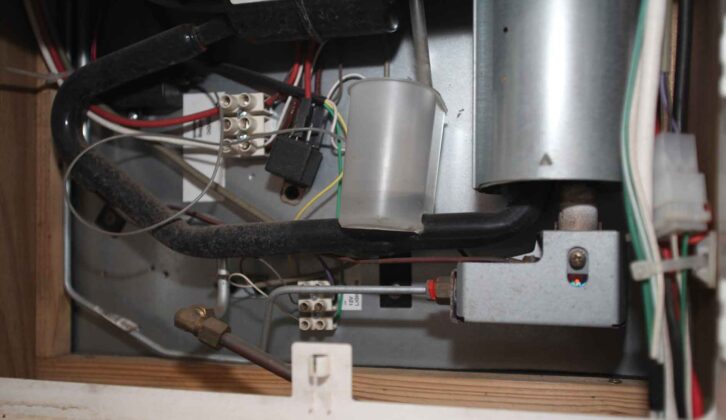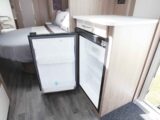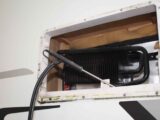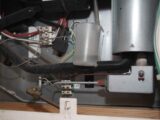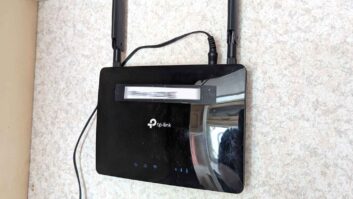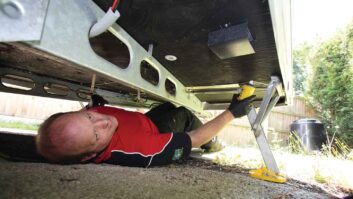Unlike a standard kitchen fridge, most modern caravan fridges use absorption technology, meaning there are no moving parts and you have ultra-reliable cooling. Even better, they work on three power sources: gas, 230V mains electricity from a hook-up, or 12V from your tow car’s engine, when you’re on the move.
The latter is a good way to initially chill your fridge as you head off on tour, but once sited, the system will most likely switch to mains or gas power, as generally, even the best caravan leisure battery would only power the fridge for a few hours at most.
In this guide, we’re talking you through the key points you need to know about a caravan fridge, as well as answering some common questions and providing some top tips to help you get the most from your tourer’s fridge.
Don’t forget to make sure you’re kitting out a caravan with the appropriate accessories either, to make sure you have all you need to hand when you’re pitched up.
Caravan fridges: all you need to know
Caravan fridges – what to do before you set off
Do caravan fridges have to be level?
Can I use a normal fridge in a caravan?
Tips to get the most out of your fridge
Caravan fridges – what to do before you set off
An important pre-tour task to carry out – it’s crucial to check that your fridge is functioning in all three modes – gas, 230V mains electricity from a hook-up, or 12V from your tow car’s engine. The last thing you want after a long, hot drive to your site is to find that your milk is identifying as cottage cheese, and your beers are scorchio.
Absorption fridges are really brilliant at keeping food chilled, but they need to be running properly on the right power source for the conditions.
Carrying out a simple test before you leave will save you the headache of spoiled food and melted ice cream when you finally pitch up. Cool heads will prevail!

Many canny caravanners like to chill the fridge the day before they set off on tour, with the van plugged in at home. Ice-packs can help to accelerate this process, as can filling (but not overfilling) the fridge with chilled provisions that won’t quickly deteriorate.
Failing to keep your fridge at the right temperature isn’t just an inconvenience, it can turn your dream trip into a nightmare. Warm food is a breeding ground for Listeria monocytogenes, the bacteria behind listeriosis, a really nasty illness that brings fever, sickness and diarrhoea.
Yep, ensuring your fridge is properly chilled isn’t just about keeping your beers cold – it’s about avoiding holiday disaster.
Do caravan fridges have to be level?
Levelling a caravan can be an important part of an enjoyable tour, but you’re also going to want to do it for your van’s fridge too. A caravan fridge must be level to work properly, because the gas moves to a heat exchanger, transferring heat outside and condensing back into liquid. This process depends on gravity, so if the fridge isn’t level, it won’t function efficiently.
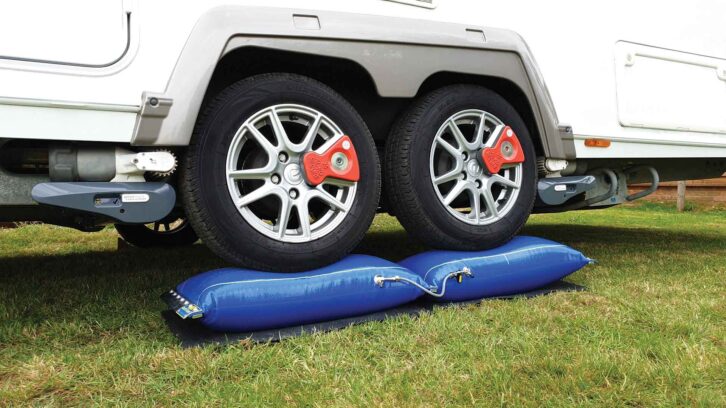
If you’re after some blocks to help you level your tourer, take a look at our pick of the best caravan levelling ramps.
Can I use a normal fridge in a caravan?
Yes, you could use a 240V household fridge in a caravan, but it’s far from ideal. While cheap, household fridges are designed for stable, level floors with ample ventilation and a steady 240V AC power supply – three things that caravans don’t always provide.
Noise is another key issue. Domestic fridges often come with frost-free systems and multi-zone cooling, but these extra features generate more noise. When you’re sleeping close to your fridge, a quieter 12V absorption (three-way) fridge is the better option.

Even with a dedicated leisure vehicle fridge, I once had to stick a plaster over the light on the control panel at 2am, because it was illuminating the entire caravan interior!
Durability is a concern, too. Standard household fridges aren’t built for the constant movement and vibrations of a caravan. Many fail prematurely, while caravan-specific models are better suited to withstand travel.
Ventilation is also crucial. Home fridges expel heat from the rear and sides, which can be inefficient if they are installed in a caravan.
Finally, the warranty may be void if a household fridge is used. Most manufacturers won’t cover mobile applications, making a 12V van fridge the smarter, more reliable choice.
18 tips to help you get the most from your caravan fridge
- Modern caravan fridges will function well, even in extremely hot temperatures. On a trip to France in 42°C heat, our Adria’s Thetford fridge, operating on mains hook-up, performed absolutely flawlessly. If only I could have climbed inside… if this is something you’ve found yourself thinking before, one of the best caravan fans could help.
- The best fridge performance is provided by 230V mains electricity, followed by gas, with 12V the least effective. Plan to use gas when you’re caravanning off-grid.
- When firing up a fridge that hasn’t been used on gas for a while, a slight burning smell is normal. We recommend running the fridge on gas for an hour or so, from time to time.
- On the drive, use an extension cable for fast and effective 230V mains cooling. If you’re away from power, use gas.
- Fill your fridge carefully, leaving space around the food for airflow. Avoid packing it so full that your provisions touch its back, inner wall.
- Bear in mind that the top shelves maintain the most stable temperatures, while the bottom shelves remain the coldest.
- Pre-freezing items such as bread and milk before packing helps them stay fresh longer and lowers the fridge temperature. Adding chilled drinks also helps the fridge to cool faster.
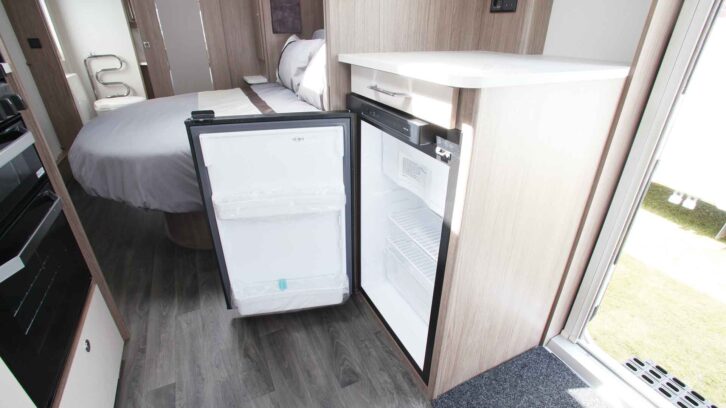
- Fridges remain cool for hours when left unopened, which is perfect for short ferry crossings. If you’re making longer crossings, buy fresh food on arrival at your destination.
- Set the fridge temperature at 1-4°C for optimal food safety. Ensure the door closes; it should ‘suction in’ slightly when the seals meet.
- If you’re cleaning a caravan at the end of a trip, don’t forget the interior either! Always empty out your fridge after trips, and keep it fresh by cleaning with warm water and bicarbonate of soda. If there are persistent odours, leave half an onion inside to absorb them.
- When the fridge is not in use, leave the door open slightly to maintain airflow – many models have door catches for this.
- Your caravan fridge should have been operated for an hour on gas during its PDI check, and a thorough fridge check is also an essential part of your annual caravan servicing regime.

- The freezer box freezes more efficiently when it’s full. Some models have a removable ice box, offering extra space in the fridge.
- Store any non-perishables away from the fridge, cooling them as needed.
- Certain fruits and vegetables, such as avocados and tomatoes, produce ethylene gas, causing any produce stored nearby to ripen too quickly.
- Dry grains, such as quinoa and lentils, will store well in the freezer compartment.
- Keep hard-stalk herbs like rosemary and thyme fresher in the fridge by wrapping them in a damp paper towel inside a resealable bag. Soft-stalk herbs, such as basil and coriander, will last longer kept in a jar with an inch of water, loosely covered with a plastic bag.
- Potatoes, onions, tomatoes, berries, bananas, melons and olive oil (which will solidify) shouldn’t be kept in the fridge, except for chilling immediately before being consumed.
Something you may want to do to bring your tourer up to date is ensure you have good access to the internet – if you’re looking for ways to do this, Nigel Donnelly can help, as he explains how to get Wi-Fi in a caravan.
Future Publishing Limited, the publisher of Practical Caravan, provides the information in this article in good faith and makes no representation as to its completeness or accuracy. Individuals carrying out the instructions do so at their own risk and must exercise their independent judgement in determining the appropriateness of the advice to their circumstances and skill level. Individuals should take appropriate safety precautions and be aware of the risk of electrocution when dealing with electrical products. To the fullest extent permitted by law, neither Future nor its employees or agents shall have any liability in connection with the use of this information. You should check that any van warranty will not be affected before proceeding with DIY projects.
If you’ve enjoyed reading this article, why not get the latest news, reviews and features delivered direct to your door or inbox every month. Take advantage of our brilliant Practical Caravan magazine SUBSCRIBERS’ OFFER and SIGN UP TO OUR NEWSLETTER for regular weekly updates on all things caravan related.
